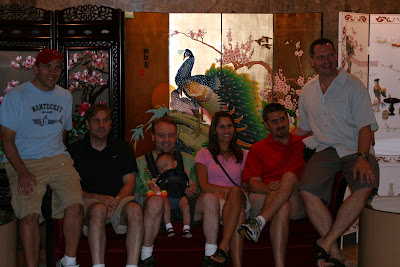This morning we awoke gave Claudia a bottle dressed and headed to Breakfast eager for the mix of Chinese and western delicacies. Claudia stuck with steamed eggs, Chinese pork, dragon Fruit and Lychees.
After that we went to the lobby to meet Grace for our last tour. While we were waiting the Dads posed for photos on the Red Couch. Danea who is Maria's friend joining them to fill in for Gracie's Dad Jim.
Then, we headed to a Buddhist Temple known as the Six Banyan Tree Temple. We all purchased incense, said some prayers, the children were blessed by ministers Cathy and Jim on the sly. The Temple was beautiful despite the dreary day.
The Temple of Six Banyan Trees has a long history in Guangzhou and is an ancient monastery famous at home and abroad. There are majestic towers, dense trees, plenty of antiques and valuable heritage from those famous people in the history. It is one of the four Buddhism temple complexes in Guangzhou and the other three are Guangxiao Temple, Hualin Temple, Haizhuang Temple. Therefore, it is an important unit for the preservation of antiques.
Temple of Six Banyan Trees was first built in the 3rd year of Datong (537 A.D.), the reign of Emperor Wu in the Southern Liang Dynasty. It was originally called Baozhuangyan Temple. It was changed successively into Chaoshou Temple, Songchu Temple in the Southern Han Dynasty. But the temple was damaged in a big fire. Later, the temple was rebuilt in the 2nd year of Duangong in the Northern Song Dynasty (989 A.D.) and was named as Jinghui Temple. In the 4th year of Shaosheng in the Southern Song Dynasty (1097 A. D.), the temple was repaired and people buried Buddha's relics under it and built thousands of Buddhist statues in the niches and hence it was changed into Qianfo Temple later. In the 3rd year of Yuanfu in the Northern Song Dynasty (1100 A. D.), Su Dongpo, a great litterateur, seeing that the six banyans were verdant and entangled with each other and full of power and grandeur, autographed the words of "Liurong"(means six banyan trees) when he visited the temple and was asked to inscribe for the temple by Daozong, a monk in the temple, on his way to the north after he was relegated from Hainan. Later, people valued Su Dongpo's handwriting and inscribed it into a wooden slab and hung it above the temple's gate. In the 9th year of Yongle in the Ming Dynasty (1411 A. D.), the Jinghui Temple was renamed as Liurong Temple, and hence the Dagoba Tower was called Temple of Six Banyan Trees, also the Flower Temple.
Next it was off to the Pearl Market for all types of jewelery...we are dressing now to head to the US Consulate and then our last dinner at Lucy's where we will be celebrating little Melynda's birthday.











.jpg)


No comments:
Post a Comment